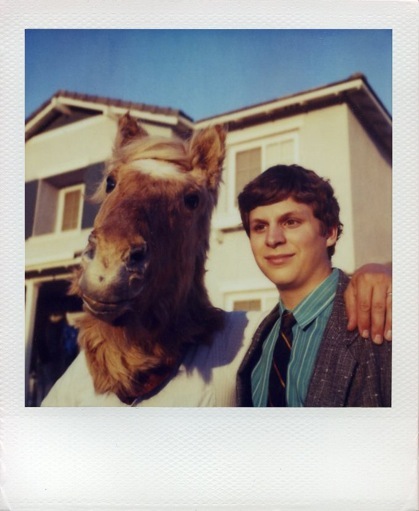
Matthew Lessner is a writer, music video director, and filmmaker. In 2011, he and producer Carlton Evans were awarded two grants by the San Francisco Film Society’s Kenneth Rainin Foundation for their feature project, Ross. His most recent film, Chapel Perilous, had its World Premiere at the 2014 Sundance Film Festival, where it won the Audience Award for Best Short Film. Chapel Perilous, Mr. Lessner’s third film to play Sundance after 2008’s By Modern Measure and 2011’s The Woods – the first Kickstarter-supported feature to premiere at the festival – stars David Henry Gerson, Kris Park, Bobby Gee, and features music by Sun Araw. Matthew Lessner spoke from Sundance 2014 with Sean Malin of CineMalin: Film Commentary and Criticism – in collaboration with Matador Network – about the pressures of being “in between features,” the nature of satire, and accusations of Illuminati conspiracy in Chapel Perilous. This interview has been transcribed, edited, and compressed from audio for publication.
*****
Sean Malin: Your newest movie is your third to play the festival in less than a decade. That’s an impressive ratio.
Matthew Lessner: It’s an interesting numbers game: Sundance is thirty this year, I’m thirty this year, and with this short, I’m back at the festival in 2014 again after my first time showing a short here in 2008 and then The Woods in 2011.
SM: You’ve made several short films, but this is your first to follow a feature film. Is it true to say one is, “in between features,” when a short filmmaker returns to shorts after a full-length movie?
ML: No, that’s actually a bit of an illusion because shorts and features are completely different experiences. For example, one of my favorite shorts at the festival this year is [Special Jury Prize winner] Rat Pack Rat by Todd Rohal, which is just amazing. It’s so unique and works so fantastically as a short – and of course, it’s from a filmmaker who has made features and will continue to make features, as I will – that you experience something totally different. That’s a similar vibe to what I’m hoping people get from Chapel Perilous, which does come in between my first feature and my second, which I shot in summer of 2013. Just because the short came chronologically between those films does not mean it didn’t keep me just as busy. The idea was to stay active and to remain engaged in a collaboration with friends, and I think we achieved that.
SM: Your movie has a specific, interior world that starts and finishes within the context of its length. I would say that goes against what some articles have referred to as the “in between” stage.
ML: I agree with that because the movie is meant to stand on its own; it is nothing lesser than a feature, contrary to how shorts are sometimes viewed in this country. Because no one has figured out a way to consistently commodify shorts in the way features are sold, they’re not treated with the same kind of reverence around America. There is a festival in France that’s known as the “Cannes of Short Films,” where the filmmakers are treated with complete respect, like the celebrities of any other festival. I’ve been lucky to go there a few times and I like to see how short films are received by the attendees.
SM: When you made Darling Darling [2005, starring Michael Cera], which brought you into the frame for a lot of people, was there an authentic sort of respect coming at you that may have worn off as you continued to make more and more movies of various styles and lengths? That movie is particularly off-the-beaten path.

ML: I don’t think so, though it has been project-to-project-dependent. I started work on a feature after The Woods, for example, that felt a little more “traditional” than that film in certain ways to people, me included. But because that movie was taking extra time to get going, I went and shot my second feature, which is in a similar vein to The Woods even though I’d written the first script long before. And seeing that finished has given me the jolt I needed to make Chapel Perilous. This was a case of just knowing some friends would be in town and wanting to make something; the final idea [for the film] came to me on a Monday and we shot it that Saturday. I loved being able to work that way.
SM: You mean, making a complete film in less than a week?
ML: *Laughs* It doesn’t have to be a week or less, necessarily; I just don’t like to work when there are too many cooks in the kitchen or too much time to overanalyze an idea. For me, it’s more exciting to say, “I don’t what this is,” when people ask about something in Chapel Perilous. It’s not important for me to understand every element of the movie, which I know frustrates some people.
SM: The new short looks professionally made to me, but you mentioned it was just you and friends making it. And you have a terrific cameo and music by Sun Araw, a respected recording artist. Was there any sort of hiring or casting process for it, or was the entire crew composed of you and buddies?
ML: I had wanted to shoot something with the two main actors, David Henry Gerson and Kris Park, who I knew were both in town. Bobby McGee, who plays Dennis the Landlord, was the actual landlord of my friend and would always approach [the friend] in the same way we have him do in the movie. So I incorporated him into the story because he was always sort of there. Our director of photography, Paul Gleason, had access to a camera, which was essential given the costs and the size of the crew. Other than that, anyone else who participated was a friend or the friend-of-a-friend who was available over the course of that week or so. I wrote the Sun Araw cameo specifically for [frontman] Cameron Stallones, who’s a friend, and he told me he was available that day to shoot.
SM: Since the assembly process on the movie was so quick, was there a lot of dialogue riffing, or does the final product mirror the original script completely?
ML: The final film and what I put down on the page are pretty close to one another, unlike The Woods, which had a lot more improvisation. Kris Park’s character, Robin, has a few choice lines that are Kris’s, but still not far from the original script.
SM: As it’s done in the past, Sundance has put a set of competing short films on their YouTube channel for the public, and the one with the highest number of views wins the Audience Award [Ed. Note: Since this interview was conducted, Chapel Perilous was awarded the Audience Award at the 2014 Sundance Film Festival]. Is YouTube a good platform for a movie like this?
ML: Whenever I have had past projects go onto YouTube, I’ve had to avoid reading the comments. But the responses to Chapel Perilous have actually been quite funny to read. A lot of people have associated us with the Illuminati, which is flattering in a way. I think we might go with that story to explain how my movies have played at Sundance three times: through Iluminati connections with Jay-Z and Beyonce *Laughs*.
SM: The title of the movie does refer to experiences with the occult, though, so I see where the commentators are coming from. Do you have any relationship with the occult, beneficial or otherwise?
ML: While I’m not a practitioner of anything occult, I am fascinated with various metaphysical concepts and ideas that many people do believe in. Recently this has come from what I was reading around the time I wrote the short, which takes a lot of ideas from the writing of Jeremy Narby. I liked that this film could engage with what are very serious ideas in a playful or lighthearted way, which is a thru-line in my work in general. Whether it’s political or social issues, like in The Woods, or something spiritual or metaphysical in Chapel Perilous, I like to be able to play around with those ideas without going too deeply, kind of like dipping my toe in the water. I also think with subjects this serious you need to engage with them in a real way, whether or not the ideas in play are totally ludicrous or substantial.

Pingback: Interview with Christopher Radcliff – Sundance/SXSW 2014 | CineMalin: Film Commentary and Criticism·